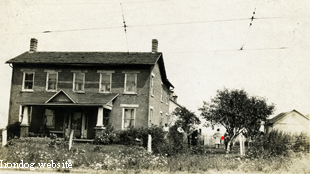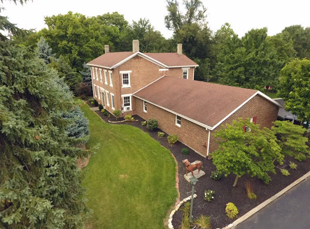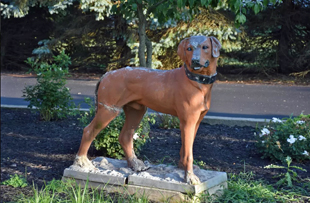As of this writing, it is difficult to determine just how much of the Tippecanoe Iron Dog's story, as reported by Edward Lewis Crane (via Kinney and Pearson) and Samuel Stuart Smith, is true. What follows is a discussion of some of the most important aspects of those accounts, and how they have held up under scrutiny.
Why was the dog made? The only stated reason for why the dog was made by the Crane's was to mark the grave of Boy Crane. This was clearly noted in both the Crane and Smith account.
Who made the dog? All accounts have the dog being made by Van Eli Crane in the family foundry in Port Huron, Michigan. Overwhelming evidence presented on the Pedigree page shows that the dog was very likely one of many made in New York, possibly by Seelig, Fiske or Mott. Furthermore, no evidence has been found to support Samuel Stuart Smith's assertion that Crane was a sculptor.
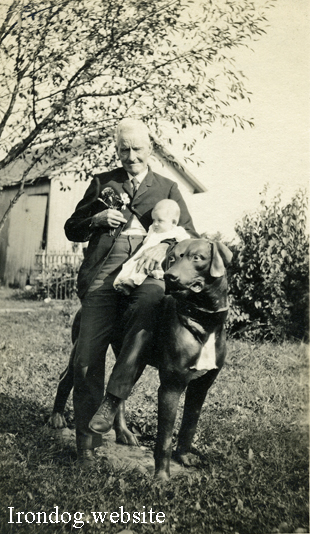
|
| William E. Clingan (1851-1933) seated on the Iron Dog, holding great-granddaughter Diana Dodds (1929-2020), ca. 1930. Photo courtesy of Mary Fair Renner, from Jeannie Davis' collection. |
Who owned the dog? Apart from the two accounts, nothing has been found thus far to document that the Cranes ever owned the dog. The first instance where the dog's ownership can reasonably be assumed is when it was placed on the farm land owned by William E. Clingan, likely around 1918. Presumably, Clingan owned the dog if it was placed on land he owned.
Who were Boy Crane's parents? Van Eli Crane is clearly identified as Boy Crane's father in all accounts. No mention of the identity of the boy's mother is found anywhere. Given the timeframe reported and marriage records located, Callie Hubbard would have to be the boy's mother, assuming Boy Crane was born to Van Crane's wife. It should be noted that a phrase found in Van's father's will, concerning Van and his children - "the heirs of his body of legal marriage" - seems to infer that Van had children out of marriage. Also worthy of note are news reports late in Van's life stating that he'd been married two times, when in fact it was at least three times. Whether he misreported this to the newspapers or they simply made a mistake is unknown.
What is known of Boy Crane? Boy Crane, around whom this story centers, remains unknown. No record of his birth or death, apart from what is reported in the Crane and Smith accounts, has been found. This, after extensive research has been conducted and documented on The Cranes page.
Where is Boy Crane buried? Boy Crane is supposed to have been buried at Maple Hill Cemetery in Tippecanoe, but no grave has been found and no records exist of the boy's burial there, or anywhere else. This, despite a significant number of Crane burials at Maple Hill prior to, concurrent with, and after the time the boy is said to have lived. All accounts mention that the dog was placed in a conspicuous location, and the Crane plots are at one of the highest points in the cemetery, well within view of the railroad tracks.
Could Smith have seen Boy Crane and the dog as he reported? Smith writes:
...I knew the little boy he was about 6 years old when he died and I was just a coukle [sic] yeasrs [sic] older. I have seen that little boy astride of that dog's back kusing [sic] him as a horse riding back and forth in that yard and where you saw the dog the boy was sure to be some where close...
...Van Crane was our Ed Crane's uncle and he at that time lived on Broadway south side of street where Catholic Parsonage and Church stands between 2nd & 3rd st...
Review of Crane and Smith landholdings in Tippecanoe City seems to indicate that the Cranes and Smiths lived near each other, and thus conceivably Smith could have been passing near the Crane house and seen the boy and dog as he reports. Of course, Tippecanoe City was not a large city, so being neighbors was not necessarily a precursor to Smith being familiar with the boy and dog. That being said, Smith's account leaves the impression that he had more than a passing familiarity with the boy, inferring that he likely lived nearby. The property that Smith identifies was purchased by Van's father in February, 1865, and presumably Van, wife Callie and their young son could have been living there during a time when Smith could have seen the boy. It should be noted that the 1870 United States Census seems to show Van and Callie, without children, living on Main Street near Van's parents, well away from the Broadway property.
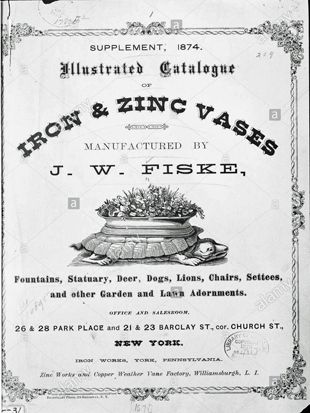
|
| The cover of an 1874 J. W. Fiske catalog. Perhaps it was this catalog, or a similar one, from which the Cranes ordered their "Iron Dog". This photograph is from the Alamy website. |
Would the Cranes have owned the dog, even if it was never intended to be placed on a grave? According to Carol Grissom in her book, Zinc Sculpture in America: 1850 - 1950:
Hence, it would not be unreasonable to conclude that the wealthy Crane family might well have acquired the dog simply because like many wealthy Americans, they were buying sculptures for their homes. This does not preclude the dog having been on a Crane boy's grave at some point, or that it was even purchased expressly for that purpose.
Could the reported location of the boy's burial be incorrect? All accounts very specifically place Boy Crane's grave at Maple Hill Cemetery in Tippecanoe, where the dog could be seen by passersby on the nearby train tracks. As no grave has been found, and no records exist showing a Boy Crane being buried at Maple Hill, is it possible that the boy's grave, with the dog, was elsewhere? The Cranes may have had a family cemetery nearby to Maple Hill, that was visible from the railroad tracks. Is it possible the dog was actually there, instead of at nearby Maple Hill? The Cranes also owned significant amounts of land south of Maple Hill - could the dog have been placed there, and seen by train passengers?
Didn't the Iron Dog become famous while on Boy Crane's grave? All accounts state that the dog became famous, with Pearson and Kinney reporting that the Associated Press picked up the story about the dog on the boy's grave, with this eventually leading to the removal of it. Significantly, no trace has been found of such articles throughout the research which is presented here.
Is anything known of persons mentioned in the Smith account?
- Smith writes that "...This thing started as a joke by a joker traveling salesman
from Tipp by name of Simon Lindsley...." United States Census records confirm a Simon
Lindsley was a traveling salesman in 1880, with a residence in Tippecanoe City. In fact,
Lindsley lived near the Cranes at one time in Tippecanoe City and his grave is
immediately adjacent to the Crane plots at Maple Hill Cemetery.
- Smith states "...E O Thomas who was the 1st conductor of the old CH&D..." United
States Census records show an Evan Owen Thomas as a railroad conductor living in Lima, Ohio in
1870 and Dayton, Ohio in 1880, both cities being on the B&O line that ran through
Tippecanoe City.
- Smith writes that "...A. W. Miles was P.M [sic] this letter came to Tipp for me
A.W.M. got my address from my mother & forwarded to me..." The 1880 United States Census
confirms that A. W. Miles was postmaster in Tippecanoe City. Smith's mother appears to
have died in 1910, meaning she was alive during the time when the Iron Dog was presumably
generating letters that were being directed to Smith.
- Smith comments in his letter to Grace Kinney, concerning his remembrances of the
iron dog events, that Mrs. Harry Ritter, Mrs. Kitty Hatshbarger, Miss Katy Born, Miss
Anna McConnahey, and Mrs. Anna Wardel Eickhoff "...would probably remember parts of it...."
It appears that all except Kitty Hatshbarger are buried in Maple Hill Cemetery and
their lifespans are roughly concurrent with Samuel Stuart Smith's.
- Of himself, Smith states "...I was a telegraph operator on CH&D Ry about 70 years ago...." Smith's obituary from 1956 identifies him a railroad telegrapher for the CH&D.
Other points of interest:
Pearson writes "...Roy Macy, whose place of business, is across the street from the former home, of the man who bought the Tipp dog, when the farm was sold, added this story. (Next door to "Bill" Clingan's house was "Jim McClure's plumbing shop.)..." Census and burial records confirm that these men existed, and that in McClure's case, he was a plumber.
Pearson identifies the Crane farm as "Arcadia" in one of his articles and "Acacia Place" in the other. Contemporary documents located during research confirm the name "Acacia" was used for the Crane farm south of Tippecanoe City.
Pearson mentions a small dog in both of his articles. writing in one "...When we visited the gravesite, we found that whoever moved the dog, had a bit of sentiment...they replaced it with a small stone dog...." There is no small stone dog currently in the Crane lot area at Maple Hill, although it could have been removed in the roughly half-century since presumably Pearson visited the grave.
Pearson opines later in that same article that "...There is another story about the molding of hands for the statue of an angel, which stands on the grave of Jean F. (Mallery) Crane. The molding was done with a pair of French gloves, still in the shape of the lady's hands...." There is no statue of an angel on Jean Crane's grave in Port Huron, Michigan. As with the small dog that is reported to have been at Maple Hill, the angel could have been removed from Jean's grave in the intervening half-century. The large sculpture marking the Crane gravesites in Port Huron has been vandalized in the past.
The Pearson accounts note that the dog was removed by Clingan. In one "...when the 1,000 acre farm was sold to the Miami Conservancy, some items, including the dog, were sold. W. E. Clingan purchased the famous dog, and placed him in front of the house, at a place called Evanston, Ohio...." The sale of the farm at that time has been documented, although no record has been located confirming the dog's sale to Clingan.
![[The Iron Dog, ca. 2008]](images/1300_720.jpg)
